|
|
|
|
|
 |
| |
| Kedah - Kota Setar |
|
|
Kota Setar is a district in Kedah.
[Back To Top] |
|
Grand Audience Hall |
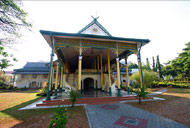
The original building was built in 1735 by Sultan Muhammad Jiwa Zainal Adilin Muazzam Shah who was then the 19th. Sultan of Kedah. The pillars, roofs and floors were made of wood. Unfortunately, the building was destroyed due to attacks by the Bugis and Siamese armada in 1770 and 1821 respectively. In 1896 the building was restored under the reign of Sultan Abdul Hamid Halim Shah who was then the 26th. Sultan of Kedah; used the venue for the wedding ceremony of His Royal Highness's five prince and princesses in 1904.
Initially the function of the building was as the Audience Hall, since then it is also used for installation ceremonies, official ceremonies, State Council Conferences besides the wedding ceremony.
|
| [Back To Top] |
| |
Hall Of Royal Music Instruments |
A three-tiered octagonal tower and the dome at its top represents the Islamic element is situated near the Balai Besar. Its main purpose is to keep all royal musical instruments belonging to the old Sultanate of Kedah, which are played on specific ceremonies such as royal installations, deaths and other official ceremonies.
Known as 'NOBAT', the nine-piece musical set is comprised of three drums, a gong, two flutes, two instruments called the cheng-cheng, and a trumpet-like instrument called the Nafiri, which produces the haunting strains of 'Nobat' music when played. The skills to play 'Nobat' music and these instruments are passed down from father to son and the person who is in-charged to play these instruments is called 'Orang Nobat'.
This tower is closed to public. Visitors must obtain permission from the State Secretariat first in order to view the "Nobat". |
| [Back To Top] |
| |
|
State Art Gallery |
The Kedah State Art Gallery was set up with the objective of fostering interest in and an appreciation of art in the state. Its collection includes paintings, photographs, musical instruments and handicrafts. Temporary exhibitions are held at regular intervals.
Built in 1893 of eastern and western architectural elements it boasts as one of the earliest modern government office built in Alor Star. Its construction was spearheaded by Muhammad Bin Lebai Tambi, an architect from Kedah State Public Works Department who was also responsible for the restoration of the Balai Besar building. Initially was the High Court before converted to its present used. |
| [Back To Top] |
| |
Kedah Royal Museum |
This building which originated from the Kota Setar Palace is a wooden building that was built by HRH Sultan Muhammad Jiwa Zainal Adilin Muazzam Shah, the 19th Sultan of Kedah, who was the founder of Alor Star town in 1735. This building had undergone demolitions several times due to attacks by the Bugis and Siamese in 1770 and 1821 respectively.
The concrete building was completed during the reign of HRH Sultan Ahmad Tajuddin Mukarram Shah. His Royal Highness had once stayed in this palace with his queen, Wan Hajar Wan Ismail who was also known as "Mak Wan Besar". Therefore, this palace is also known as the "Mak Wan Besar Palace".
After the Second World War ended in 1941, this palace was used as a school and an office for several organizations including the office for the St. John and the Scout movements. On 25 July 1983, this palace was declared the "Kedah Royal Museum". |
| [Back To Top] |
| |
|
Zahir Mosque |
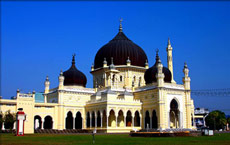
Built in 1912 was a contributory effort of then the Crown Prince, Tunku Mahmud Ibni. The mosque of Moorish inspired architecture encompasses of five large domes symbolizing the five Islamic principles.
The site of the mosque before it was built was the cemetery of the Kedah warriors who had died while defending Kedah from Siamese attack in 1821. It occupies approximately 124,412 sq. ft. Its center Prayer Hall measures 62 x 62 sq. ft. and surrounded by verandahs of 8 ft. wide with 4 mezzanine areas of which each has a dome.
|
| [Back To Top] |
| |
Wat Nikrodharam |
The most commanding and important Buddhist shrine in the city. Its architecture reflects strong Thai elements with minor Chinese motifs. It's a sanctuary and oasis in the city centre with trees and shades providing spiritual shelter to Buddhists from the city and abroad. |
| [Back To Top] |
| |
State High Court |
Located at the junction of Jalan Putera is nearby to the Hall Of Royal Instruments. The building characterizes Roman architecture. Built in 1922 were under the responsibilities of HRH Sultan Abdul Hamid Halim Shah (Regent), W. Peel Esq (British Adviser), Major W.R. Sanguinetti, O.B.E.M.C (State Engineer), F.W. Wade Esq. A.I.R.B. (Architect) and H.W. Fofden Esq (Contractor). |
| [Back To Top] |
| |
|
Alor Star Tower |
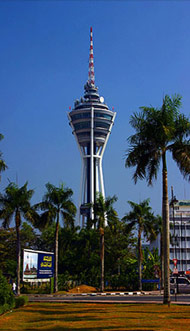
Popularly visited for a panoramic viewing of the Alor Star cityscape, it stands at 165.5 m. tall is a prominent and modern landmark that signifies the rapid development of the State. It functions as both a telecommunications tower and a tourist attraction. The tower's platform allows visitors to enjoy a breathtaking view that stretches from Gunung Jerai to the Starits of Malacca. From the tower, one can view a vast expanse of paddy fields which lies outside of Alor Setar; an amazing view to behold especially during harvest time. It's the second tallest tower in Malaysia after KL Tower and ranked 19th. in the world.
|
| [Back To Top] |
| |
|
Kuala Kedah Fort |
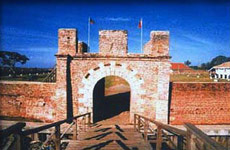
The remains of a history-filled fort situated at the estuary of the Kedah River was built by Indian stone masons in the early 17th. century with the help of the Portuguese to ward off Kedah's adversaries.
|
| [Back To Top] |
| |
|
Mahathir's Birth Place |
|
Built in 1900 at Kampung Seberang Perak is the birth place of Tun Dr. Mahathir Bin Mohamad, the fourth Malaysian Prime Minister. There are exhibits from the days of his childhood to his schooldays and the time he became a doctor.
Tun Dr. Mahathir Mohamad born on July 10, 1925 held the post of Malaysia's Prime Minister from 1981 to 2003. During his term in office he was credited for engineering Malaysia's rapid modernization and resulting growth of prosperity. Another of Mahathir's central issues is the promotion of "Asian Values".
|
| [Back To Top] |
| |
|
Wednesday Market |
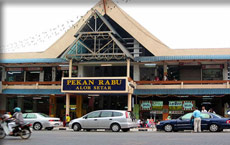
Built in 1967 is believed to be the first shopping complex that gathers everyday needs such as traditional medicine, crafts and clothes under one roof. Located near government offices in Alor Star is open all week long although its name literally means "Wednesday Market".
|
| [Back To Top] |
|
|
|
|
| Hotel |
CITY / TOWN / AREA |
Type |
| |
|
|
|
|
|
|
|
|